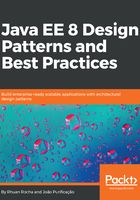
Implementing the data-access object pattern
To implement this pattern using the best practices of Java EE 8, we will use a relational database and implement the data read and write using a JPA specification. In this example, we will have one table named employee, which contains the employee data. We will also create a class called EmployeeDao which will have four methods – save(employee), findByName(name), findAll(), and delete(employee). The save method will receive one employee and save them on the database, findByName will receive the name as a parameter and will find the employee by name on the database, and delete will receive an employee and delete them from the database. Also, we are going to create a transfer object called Employee, a class that is a JPA entity and has the mapping to a database table.